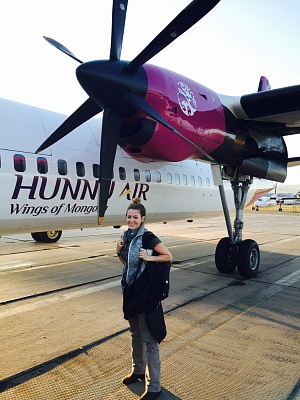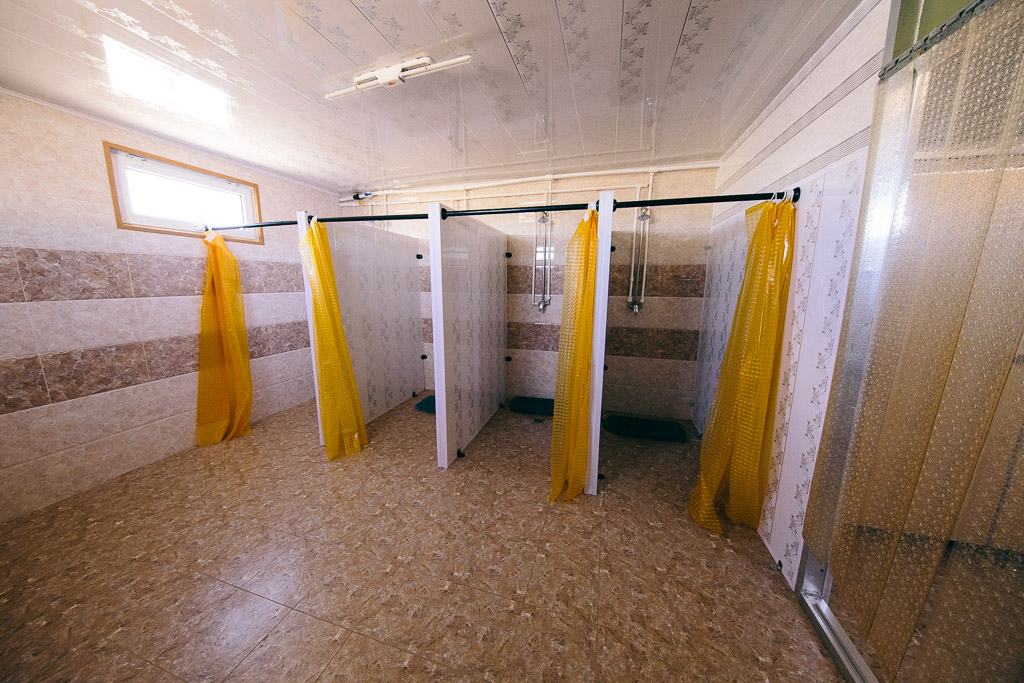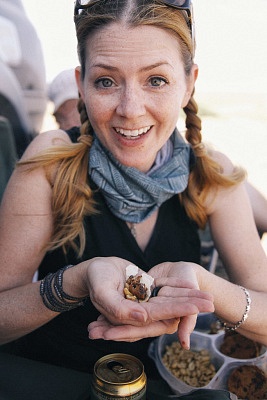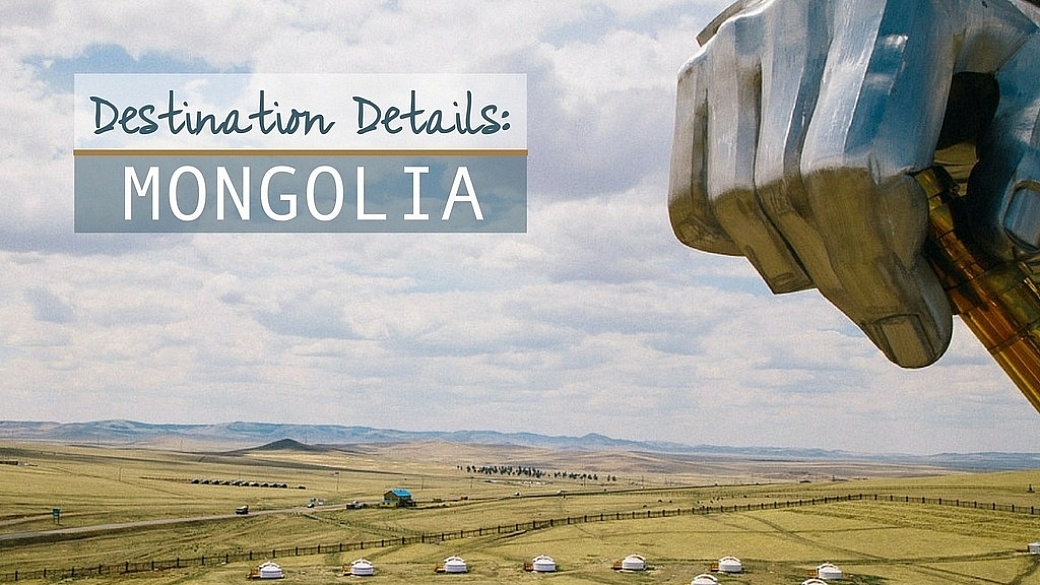Before I left to traipse across the Eurasian steppe, my bigger task was figuring out how the heck to prepare for a trip to Mongolia. I had to pack for the daytime heat and the nighttime cold of the Gobi Desert, one challenge of traveling to Mongolia. I didn’t have a lot of room in my suitcase but had to accommodate wardrobe for camel rides and sand dune climbs, temple visits, and dinners out in the city. Then there were the sundry items: camping and camera equipment, first aid items and back-up food – because Mongolian food is meat-heavy and after awhile the sour taste of vinegar and yak milk piques your taste buds.
My time in the somewhat harsh landscape of this vast country was spent with several days in Ulaanbaatar, an incongruent metropolis settled in the middle of rolling hills. The city was a mixture of ancient temples, blocky soviet housing and an infrastructure that appeared to be crumbling before the concrete sidewalks had cured. There was also a few nice restaurants, an upscale shopping mall and an Irish pub. I’ve yet to visit a country too remote to have an Irish pub, a fascinating phenomenon unto itself.

My favorite ger camp in Terelj National Park, in which a herd of baby yaks ran through. Baby yaks!
The other part of my time traveling through Mongolia was spent moving from one ger camp (commonly known as a yurt) to another across the browns of the barren Gobi Desert and the green of the national parks. Electricity was rationed at times, showers were often cold, and the food was mostly pickled or canned, brought in as it was from Russia and China.
Are you planning a trip to Mongolia? What can you expect? How do you prepare? Below are my answers to some of the more frequently asked questions. I hope it helps you!

Straight out of Mongolian Vogue. Photo by Ragan Brooks @BeautyintheBite
Q: What kind of clothes and shoes should I pack?
A: If you are traveling to Mongolia during the main tourist seasons of June – August, the weather will be warm to hot. Pack casual clothes and comfortable shoes for exploring the city. Ulaanbaatar is a modern city with a vibrant nightlife so expect to dress for warm summer nights when dining or going out.
You will have to pack light, there’s not a lot of room for heavy bags whether you feel like you can carry them or not. In fact, on the prop plane down to the Gobi, you have a weight limit on your bags, so you may wind up leaving some items in UB during that part of your trip like I did.
For the Gobi Desert, expect hot temperatures during the day and bring lightweight layers for the evenings, as it can get chilly after the sun goes down. During the day, lightweight hiking pants for rugged adventures or camel riding are good. If you have those zip-off convertible pants, this might be the one time you won’t cringe with embarrassment at wearing them. I mean, I’ve never bought them, but a) there is no one in the desert to laugh at you and b) when you set out in the morning you’re chilly, but by afternoon you just want to take off everything and find a water puddle to cool off in. Even a mirage will do at this point, you’re so hot. Who’s laughing now? If you can’t bear to buy a pair of all-in-one pants, you may want to bring a pair of hiking shorts for hotter days, but you’ll be cold in the morning when you leave to explore.

My pullover came in handy every morning. I’m sure I slept in it a time or two. Also: GOATS!!
Laundry service is available at most ger camps, but most do not have clothes dryers so pack fabrics that dry quickly (not denim). I’m also a big proponent of lightweight button-down shirts for sun protection over tank tops. Layers, man. They are the key to everything.
For nighttime bring lightweight wool long underwear pieces and fleece vests or jackets. I thought I would need gloves but I didn’t wind up wearing them, save for one hour when the weather dipped down to a 50* F and a heavy wind blew through.
For shoes, it’s good to bring hiking boots or other sturdy footwear that have non-slip soles for adventures outside the city. If you prefer sandals, bring a pair that are water resistant with rubber tread, toe coverage and securable straps, but know that you might get sand in them outside of the city. Or maybe, even inside the city. Flip-flops are good for shower areas and evenings around the camp.

Weight is everything on these small propeller planes so PACK LIGHT.
Q: What bags should we bring for our trip?
A: It’s best to pack as light as possible. When you are in Ulaanbaatar, you will have space for a regular checked piece of luggage in your hotel room. Be sure to pack a smaller soft-side duffle bag or large backpack for your time in the Gobi and/or Lake Khovsgul. For these portions of the trip you will be flying on a 60-seat turbo-prop aircraft and then 4WD jeeps, which do not have space available for larger bags. You will also have room for a small carryon or camera bag during these excursions.
If you are with a tour group like I was when traveling to Mongolia, during your trips to the Gobi or Lake Khovsgul your main checked baggage will stay locked up at the hotel and delivered to you upon your return to the city.

You’re gonna need cash for the essentials out in the desert.
Q: How much cash money do I need in the desert?
A: For a 10-day tour you may want to have between 200 – 300USD worth of local currency available. Outside of normal shopping, you will need cash on hand for beverages (soda, wine, beer – which were available at every ger camp), souvenirs, any tip money for the drivers, baggage handlers at the ger camps, or for horse or camel rides. International credit cards are accepted at many places in Ulaanbaatar, but not outside of the city. You will need local currency before leaving the city, which you can change at your hotel, banks or through ATMs.
Q: Is there mobile reception or data outside of Ulaanbaatar?
A: Mobile reception is available in most parts of the country, but not all. You may have reception near and in some small towns, and Wi-Fi is available at a few of the ger camps.
If you have an unlocked smartphone, you may purchase a Mongolian SIM card from Mobicom. There is a Mobicom counter on the third floor of the State Department Store in the middle of Ulaanbaatar. As of this writing, a SIM card is 18USD for local calls and texts, 11USD for 5GBs of data, and 5USD for 50 minutes of talk time to the United States. 5GBs of data should easily last the entire trip and you will have phone and Internet services in most locations throughout the trip with the exception of the Gobi Desert.

Karaoke is a well loved in Mongolia. I’m fairly certain it turned off in the middle of my song because of electricity rations in the Gobi, and NOT because of my singing. Right??
Q: Is there electricity at the ger camps?
A: Yes, but sometimes it can be limited as a generator typically provides it. Each ger camp is different, but you should inquire about the hours that electricity will be available and plan to charge any devices, batteries or use any electrical appliances within that window. Usually it is during waking hours, so plan to have an additional light source such as a small flashlight or headlamp for evening in the ger camp.
I can’t say enough about bringing a headlamp. At night, when you’re getting ready for bed, there are very few powered lights to guide you to the separate bathroom areas. Wearing your light on your head allows you to easily see where you are heading while leaving your hands free to carry your towel and toiletry bag.
Q: Are bath towels provided at ger camps?
A: Yes. There is no need to pack your own towels, though you may want to bring a face towel or washcloth as some camps only provide larger body towels in the shower rooms. Clean pillowcases are provided at every camp, but since typically only cold water is available for laundry, they may show stains. If you prefer, you may want to bring your own pillowcase. Just remember to grab it every morning before you move camp.

Typical showers at the ger camps. Bring your own soap.
Q: Will toiletries (shower gel, shampoo, soap) be provided at the ger camps?
A: It varies. Each camp is different, and while some may provide shower gel inside the stalls, not all do. It’s best to pack travel-sized versions of your favorite toiletries for the entire time you are outside of Ulaanbaatar. It’s also good to pack them in a portable dopp kit or zipper bag so that you can easily carry them back and forth to the shower and restrooms, which are a separate area in the camp.

While it was fantastic to have vegetables in Mongolia, by day six of the beet, pickle, carrot diet you’re wishing for a little diversity.
Q: Should I bring my own food?
A: Short answer: yes.
Longer answer: Of course you can be a real mountain man and live off of the land. But I’m a pescetarian, and I had the fear of not seeing any vegetables for ten days drilled into me by those that had gone before me. This didn’t happen to be the case and I think if you are staying in ger camps throughout Mongolia, the food is more varied and you will see veggies in the form of salads and side dishes. Be prepared for a LOT of beets and cabbage, most often pickled. For breakfast we frequently had eggs, sometimes pancakes and always meat. Lots and lots of mystery meat, the likes of which caused about half of our group to request vegetarian meals by week two.

Sometimes you make do with airline peanuts, some Pringles you found at the market and some Keebler cookie bits. #desertmix
So what might you want to pack? Another member of our group brought oatmeal packets, tuna in a foil pouch and salmon jerky. I brought along a dozen protein bars, nuts, dried fruit, and what turned out to be my biggest lifesaver: peanut butter in individual packets. I can tell you that after a week of choking down pickled carrots, there is nothing better than a sweet, sweet peanut butter and jelly sandwich cobbled together from items already at the table and my beautiful packet of Justin’s peanut butter. Be careful though, the rest of your group might be staring at your sandwich longingly, plotting to throw you over for a single packet of that magic spread.
I think this covers the major questions about how to prepare for a trip to Mongolia, but if I missed anything, please let me know down in the comments section!
Anything else you’d like to know about traveling to Mongolia?













19 Comments